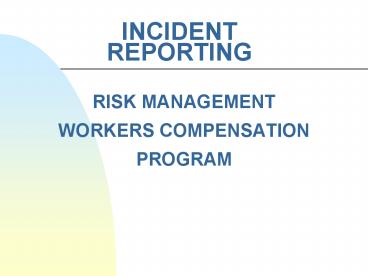INCIDENT REPORTING - PowerPoint PPT Presentation
1 / 15
Title:
INCIDENT REPORTING
Description:
All incidents and accidents involving employees, no matter how insignificant they seem. ... How will my pay be affected? Where will my assignment be located? ... – PowerPoint PPT presentation
Number of Views:108
Avg rating:3.0/5.0
Title: INCIDENT REPORTING
1
INCIDENT REPORTING
- RISK MANAGEMENT WORKERS COMPENSATION PROGRAM
2
WHAT SHOULD BE REPORTED?
- All incidents and accidents involving employees,
no matter how insignificant they seem. - This documents relative facts.
- Provides a loss control tool.
3
REPORTING EMPLOYEE INCIDENTS
- For injuries NOT requiring Medical Treatment
(minor injuries that do not require immediate
medical treatment other than first aid), the
Employee needs to - Notify your agency Workers Compensation Contact
- Assist the Contact in completion of an on-line
incident report and file with Risk Management - Completing and filing this form with Risk
Management Workers Compensation serves as a
record of notification to your employer in the
event you require medical treatment in the future
(up to one year). - An on-line incident report should be submitted to
Risk Management Workers Compensation within 24
hours of receiving the report of injury.
4
REPORTING EMPLOYEE INCIDENTS
- For injuries that do require Medical Treatment,
the Employees Supervisor/Workers Compensation
Contact needs to - ? Complete First Report of Injury Form, (SFN
2828) and file it with Workforce Safety
Insurance (WSI) within 24 hours after learning
of the injury. Traumatic Injuries require - Supervisor to immediately file the SFN 2828 and
notify Risk Management by phone (328-7583), fax
(328-7585) or email (drwaliser_at_nd.gov) and - Employee must complete SFN 2828 as soon as
possible thereafter.
5
REPORTING EMPLOYEE INCIDENTS
- For injuries that do require Medical Treatment,
the Employee needs to - Notify your agency Workers Compensation Contact
- Assist the Contact in completion of an on-line
incident report and file with Risk Management - Complete SFN 2828 Sections 1 and 2 and file it
with Workforce Safety Insurance - Obtain initial treatment from the pre-selected
designated medical provider - Have care provider complete C-3
- Return C-3 to supervisor or Workers Compensation
Contact as soon as possible, but no longer than
24 hours after treatment.
6
REPORTING EMPLOYEE INCIDENTS
- I filed a Workers Comp Claim - NOW WHAT
- You will be contacted by a Claims Adjuster from
Workforce Safety Insurance and if the claim
results in lost work time you will be contacted
by a Nurse Case Manager. - These professionals will assist you with your
claim and help answer any questions that you may
have.
7
REPORTING EMPLOYEE INCIDENTS
- You will also receive in the mail a letter from
Workforce Safety Insurance notifying you that
your claim has been accepted or denied. - If your claim is denied the letter will also
explain what steps you can take to have your
claim reviewed. - AT ALL TIMES YOU ARE REQUIRED TO FOLLOW THE
REQUIREMENTS SET FORTH BY YOUR MEDICAL PROVIDER
AND WORKFORCE SAFETY INSURANCE.
8
REPORTING EMPLOYEE INCIDENTS
- What if my injury wont allow me to return to
my regular job for a while? - You will be placed in Transitional Duty until you
can do your regular job. - Transitional Duty is work that is modified to
meet the restrictions placed on you by your
medical provider. - All attempts will be made to find Transitional
Duty in your agency - however if this is not
possible you may be placed with another agency.
9
REPORTING EMPLOYEE INCIDENTS
- QUESTIONS ON TRANSITIONAL DUTY
- How long will I be on Transitional Duty?
- Will my assignments change?
- How will my pay be affected?
- Where will my assignment be located?
- What are the benefits of Transitional Duty?
- Can I elect not to participate?
10
WHEN WILL TRANSITIONAL DUTY END?
- 90 days after starting of the assignment
- You are released to your pre-injury position
- The assignment is no longer available
- The workers compensation claim is denied
- Transitional work with the employing agency is
available - The restrictions become permanent
11
ABOUT TRANSITIONAL DUTY
- This is a temporary position
- The job duties will change as medical
restrictions and limitations change - The work will be meaningful
- The work will be within 25 miles of your regular
job
12
HOW WILL I BE PAID?
- You will remain in your regular classification
and position - Wages and benefits will be prorated for hours
worked - Wages are supplemented up to 66.6 by NDWC
- You can use leave benefits to keep pay at regular
level
13
COMMUNICATION
- The Worker, Supervisor, RMWCP, and WSI must be
kept informed about - Benefit information
- Medical Treatments
- Concerns of the worker
14
BENEFITS OF TRANSITIONAL DUTY
- Speeds up recovery
- Keeps employees working
- Reduces compensation costs
- Prevents abuse
15
IS TRANSITIONAL DUTY MY CHOICE?
- You can elect not to participate in your
transitional duty assignment- however, it may
affect the benefits you receive from Workforce
Safety Insurance.































